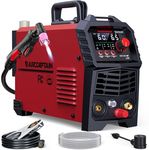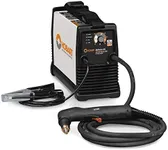Buying Guide for the Best Plasma Cutters
Choosing the right plasma cutter can make a big difference in how easily and efficiently you can cut through metal. The best plasma cutter for you depends on what kind of materials you plan to cut, how thick those materials are, and where you’ll be using the machine. Understanding the key specifications will help you match a plasma cutter to your needs, ensuring you get a tool that’s powerful enough for your projects but not more complicated or expensive than necessary.Cutting Capacity (Thickness)Cutting capacity refers to the maximum thickness of metal that the plasma cutter can cut through cleanly. This is important because using a cutter that’s too weak for your material will result in poor cuts or even damage the machine. Plasma cutters are usually rated for a 'clean cut' (a smooth, precise cut) and a 'severance cut' (the absolute maximum thickness it can cut, but with rougher results). For light work like auto body repair or hobby projects, a lower cutting capacity (around 1/4 inch) is often enough. For heavier fabrication or industrial use, you’ll want a machine that can handle 1/2 inch or more. Always choose a cutter that matches or slightly exceeds the thickest material you plan to cut most often.
Input Power (Voltage)Input power is the type of electrical supply the plasma cutter needs to operate, usually measured in volts. Some cutters run on standard household power (120V), while others require higher voltage (220V or more) for greater cutting power. Lower voltage machines are more portable and suitable for lighter tasks, while higher voltage models are better for thicker materials and longer cutting sessions. Consider where you’ll be using the cutter—if you only have access to standard outlets, a 120V model may be best, but if you have access to higher voltage, you can choose a more powerful machine.
Amperage RangeAmperage range tells you how much electrical current the plasma cutter can use, which directly affects its cutting power. Lower amperage is suitable for thin metals and detailed work, while higher amperage is needed for thicker materials. Plasma cutters often have adjustable amperage, so you can set it according to your project. If you mostly work with thin sheet metal, a lower maximum amperage is fine. If you need to cut a variety of thicknesses, look for a wider amperage range for more flexibility.
Duty CycleDuty cycle is a measure of how long the plasma cutter can operate continuously before it needs to cool down, usually expressed as a percentage of a 10-minute period. For example, a 60% duty cycle at a certain amperage means the cutter can run for 6 minutes and then must rest for 4 minutes. A higher duty cycle is important if you plan to make long or frequent cuts, as it reduces downtime. For occasional or short cuts, a lower duty cycle is usually sufficient.
Air Supply RequirementsPlasma cutters need a supply of compressed air to create the plasma jet. Some models have built-in air compressors, while others require an external air compressor. Built-in compressors make the cutter more portable and convenient, but may be less powerful. External compressors can provide more air for longer or thicker cuts, but add to the setup. If you need portability or will be working in different locations, a built-in compressor is handy. If you already have a good air compressor or need to cut thick materials, an external supply may be better.
Portability (Weight and Size)Portability refers to how easy it is to move and transport the plasma cutter. Lighter, more compact models are easier to carry and store, making them ideal for mobile work or small workshops. Heavier, larger units may offer more power but are less convenient to move. Think about where you’ll use the cutter most—if you need to take it to different job sites, prioritize portability. If it will stay in one place, size and weight are less important.
Pilot Arc FeatureA pilot arc is a feature that allows the plasma cutter to start the arc without touching the tip to the metal. This makes it easier to cut through painted, rusty, or expanded metal and extends the life of the consumables. If you often work with dirty or coated materials, or need to cut through mesh or grates, a pilot arc feature is very helpful. For clean, flat metal, it’s less essential but still a nice convenience.
![ARCCAPTAIN 60Amp [Non-HF] Plasma Cu](https://images-proxy.bestreviews.guide/XFb2mTFKSM3crl1QuKZ69s7usns=/0x150/https://m.media-amazon.com/images/I/51cupDUi08L._AC_CX679_.jpg)
![bestarc Plasma Cutter, [Pilot Arc]](https://images-proxy.bestreviews.guide/vVYVpzuTXRA0_H5bJEmQdwW3YXo=/0x150/https://m.media-amazon.com/images/I/511NRqmaxiL._AC_CX679_.jpg)


![bestarc Plasma Cutter, [Pilot Arc][](https://images-proxy.bestreviews.guide/NhDkg7fZy3CL59GCnz2LdZGyj3A=/0x150/https://m.media-amazon.com/images/I/41eche7zU-L._AC_CX679_.jpg)














